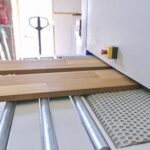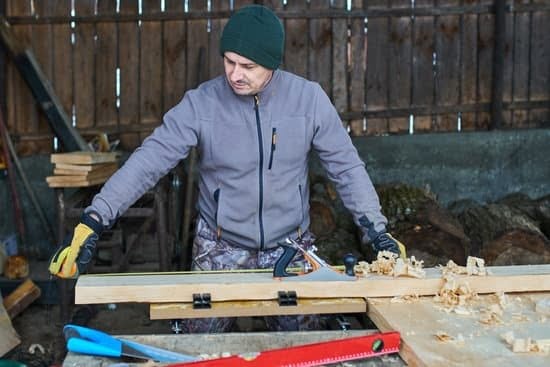What is an apron in woodworking? Woodworking aprons play a crucial role in the craft, providing protection, functionality, and convenience for woodworkers. From traditional hand tools to modern power tools, aprons have been an essential accessory for woodworkers of all skill levels. This article aims to explore the significance of woodworking aprons and their role in traditional woodworking techniques.
The history of aprons in woodworking is rich and varied, with different designs and uses evolving over time. From carrying essential tools to protecting clothing from sawdust and sharp objects, woodworking aprons have always been a staple in the workshop. Understanding the origins of these aprons can provide insights into their practicality and importance in woodworking.
In addition to delving into the history of woodworking aprons, this article will also explore the different types of materials, styles, and features available in today’s market. Whether it’s leather or canvas, with pockets or tool loops, woodworkers have a range of options to choose from when selecting the right apron for their needs. Understanding these options can help woodworkers make informed decisions about their protective gear.
History of Aprons in Woodworking
The history of aprons in woodworking is a rich and storied one, dating back to ancient civilizations and evolving over time to meet the needs of craftsmen. The use of aprons in woodworking can be traced back to early carpenters and woodworkers who needed a protective garment to shield their clothing from sawdust, shavings, and other debris. In addition to protection, aprons also served as a convenient way to carry essential tools and small items necessary for woodworking.
In the early days of woodworking, aprons were simple garments made from durable fabrics such as leather or canvas. These aprons were often designed with multiple pockets and tool loops to hold hammers, chisels, measuring devices, and other necessary implements. As woodworking techniques advanced over time, so did the design and functionality of aprons. The evolution of apron styles and features in woodworking mirrors the progression of tools and tasks within the craft.
Throughout history, woodworking aprons have been an indispensable accessory for craftsmen, providing both practicality and protection. From ancient artisans crafting wooden furniture and structures to modern woodworkers creating intricate designs with power tools, the apron has remained a staple in woodworking attire.
| Woodworking Apron History | Key Points |
|---|---|
| Origin | Began with early carpenters needing protection from sawdust |
| Evolution | Designs evolved alongside advancements in woodworking techniques |
| Practicality | Ancient artisans to modern woodworkers continue to use for practicality & protection |
Types of Woodworking Aprons
Woodworking aprons come in a variety of materials, styles, and features, each tailored to the specific needs and preferences of woodworkers. From durable leather to versatile canvas, these aprons are designed to provide protection and functionality while working in the shop. Additionally, pockets and tool loops are common additions that enhance the usefulness of woodworking aprons.
Materials
One of the key factors in choosing a woodworking apron is the material it is made from. Leather aprons are known for their durability and ability to protect against sharp tools and flying debris. They also offer a classic look that many woodworkers prefer. On the other hand, canvas aprons are lightweight and breathable, making them more comfortable for extended use. Other materials such as denim or waxed cotton are also popular choices for woodworking aprons.
Styles
Woodworking aprons come in various styles to accommodate different preferences. Some feature full coverage with bibs that extend up to the chest, providing maximum protection against dust and stains. Others have a half-apron design that focuses on protecting the lower body while allowing more freedom of movement for the upper body. Additionally, there are cross-back designs that distribute weight evenly across the shoulders instead of pulling on the neck.
Features
Pockets and tool loops are common features found on woodworking aprons that add to their functionality. Pockets allow woodworkers to keep essential tools and fasteners within reach, reducing the need to constantly move back and forth between workstations or benches. Tool loops provide a convenient way to store larger or longer tools without occupying pocket space, keeping them secure while working.
Understanding the different materials, styles, and features of woodworking aprons is essential for woodworkers looking to invest in an apron that suits their individual needs and preferences. Whether it’s leather or canvas, full coverage or half-apron design, with pockets or tool loops – choosing the right woodworking apron can greatly enhance comfort and efficiency in any workshop setting.
Functionality of Woodworking Aprons
Protection From Sawdust
Woodworking aprons play a crucial role in protecting woodworkers from sawdust, wood chips, and other debris that can be generated during the woodworking process. The apron acts as a barrier between the body and these particles, preventing them from settling on clothing and skin. This not only keeps the woodworker clean but also reduces the risk of respiratory issues that can arise from inhaling sawdust.
Carrying Tools
One of the key practical uses of woodworking aprons is their ability to carry essential tools within easy reach. Many woodworking aprons come equipped with pockets, loops, and slots designed to hold various tools such as chisels, markers, measuring tape, and even small power tools. This allows woodworkers to have immediate access to the tools they need without having to search around the workshop or leave them lying on work surfaces where they can pose a safety hazard.
Providing a Surface for Small Tasks
Another important function of woodworking aprons is their ability to provide a convenient work surface for small tasks. Whether it’s holding nails while hammering, providing a place to wipe hands or tools, or offering a spot to temporarily place small parts or hardware, the apron becomes an extension of the workbench itself.
This can save time and effort by eliminating the need to constantly walk back and forth to retrieve items or find an appropriate surface for these minor woodworking tasks. Finally understanding what is an apron in woodworking includes knowledge of its practical uses such as protection from sawdust, carrying tools, and providing a surface for small tasks.
DIY Woodworking Aprons
Woodworking aprons are an essential part of any woodworker’s toolkit. They not only provide protection from sawdust and wood chips, but they also serve as a convenient way to carry tools and provide a surface for small tasks. But what is an apron in woodworking? An apron in woodworking is essentially protective clothing worn over the front of the body to protect against potentially harmful elements such as flying debris, spills, or accidental contact with sharp or hot tools.
One of the advantages of making your own woodworking aprons is that you can customize it to fit your specific needs and personal style. There are many different materials to choose from when making DIY woodworking aprons, including leather, canvas, denim, or waxed cotton. Each material has its own benefits – leather provides durability and strength, canvas offers breathability, while denim and waxed cotton offer water-resistance.
When selecting the fabric for your DIY woodworking apron, consider factors such as comfort, durability, and ease of cleaning. You will also need to decide on the style and features you want your apron to have – whether you want pockets for storing tools or loops for hanging equipment.
Once you have chosen the materials and style that best suit your needs, you can start on constructing your custom woodworking apron using basic sewing techniques such as measuring, cutting fabric pieces to size, and stitching them together.
Making your own DIY woodworking apron not only allows you to create a customized piece tailored exactly to your preferences but also gives you a sense of satisfaction from creating something by hand. Plus it can be a cost-effective way to acquire a high-quality woodworking apron without breaking the bank.
| Types of Material | Main Benefits |
|---|---|
| Leather | Durability and strength |
| Canvas | Breathability |
| Denim/Waxed Cotton | Water resistance |
Importance of Proper Fit
Woodworking aprons are a crucial accessory for any woodworker, providing both protection and utility in the workshop. However, one of the most important aspects of a woodworking apron is ensuring that it fits properly. A properly fitted apron not only contributes to the comfort of the woodworker but also affects their mobility and safety while working with tools and machinery. Here are some key reasons why the proper fit of a woodworking apron is essential:
- Comfort: A well-fitted woodworking apron is comfortable to wear for extended periods. It allows the woodworker to move freely without restrictions or chafing, preventing distractions during the woodworking process.
- Mobility: Properly fitted aprons enable woodworkers to move around the workshop with ease, bend, stoop, and reach for tools without hindrance. This unrestricted movement is essential for maintaining productivity and efficiency during woodworking projects.
- Safety: A correctly sized apron ensures that no loose fabric or dangling straps pose a risk of getting caught in power tools or machinery. This can help prevent accidents and injuries in the workshop.
In order to achieve a proper fit, woodworkers should consider their body measurements and personal preferences when selecting an apron. Different styles and designs of woodworking aprons cater to various body types, so it is important to try on different options before making a purchase.
Additionally, adjustable straps or belts on woodworking aprons allow for customization to fit individual body shapes and sizes. By taking the time to find an apron that fits well, woodworkers can optimize their comfort, mobility, and safety while pursuing their craft.
Lastly, since woodworking tasks often require bending over or kneeling down, it’s important that the length of the apron does not hinder these movements. Woodworkers should ensure that the bottom edge falls at an appropriate height according to their individual height and range of motion. This attention to detail ensures that the apron serves its purpose without impeding workflow in any way.
Maintenance and Care of Woodworking Aprons
Woodworking aprons are essential for protecting garments, carrying tools, and providing a work surface for small tasks. It is important to properly maintain and care for these aprons to ensure their longevity and continued performance in the workshop. Follow these tips and advice for cleaning, maintaining, and preserving your woodworking aprons:
1. Cleaning: Regular cleaning of woodworking aprons is necessary to remove sawdust, dirt, and stains that may accumulate over time. Depending on the material of the apron, follow specific cleaning instructions to ensure it is not damaged in the process. For canvas aprons, a gentle machine wash with mild detergent may suffice, while leather aprons may require spot cleaning with a damp cloth.
2. Maintenance: Inspect your woodworking apron regularly for any signs of wear and tear such as loose stitching or fraying edges. Address any issues promptly to prevent further damage and ensure the integrity of the apron. Reinforce seams if necessary and replace any worn-out straps or fastenings to maintain functionality.
3. Preservation: Proper storage is crucial for preserving woodworking aprons when not in use. Hang them in a dry, well-ventilated area to prevent mold or mildew growth. Avoid exposure to direct sunlight or extreme temperatures which can cause fading or deterioration of the fabric.
By following these maintenance and care tips, you can extend the life of your woodworking apron and continue to enjoy its benefits in your woodworking endeavors.
Conclusion
In conclusion, woodworking aprons play a crucial role in the craft of woodworking, providing protection, functionality, and convenience for woodworkers of all levels. From their historical origins to the different types and designs available today, aprons have evolved to meet the needs of modern woodworkers while still honoring traditional techniques. Whether it’s leather, canvas, with pockets or tool loops, there is a woodworking apron out there for every craftsman.
It is important for woodworkers to understand the practical uses of aprons in woodworking, including protection from sawdust and carrying essential tools within reach. Additionally, making your own woodworking apron can be a fulfilling DIY project that allows you to customize it according to your specific needs and style. Furthermore, investing in a properly fitted woodworking apron not only ensures comfort and mobility but also contributes to maintaining safety in the workshop.
As readers continue their woodworking endeavors, it is crucial for them to consider investing in a quality woodworking apron that meets their specific needs. By understanding the history, types, functionality, and maintenance of woodworking aprons, craftsmen can make an informed decision on selecting the right apron for their workshop activities.
Whether it’s for personal use or as a gift for fellow woodworkers, a well-chosen woodworking apron is an essential tool that should not be overlooked in the world of woodworking.
Frequently Asked Questions
Why Do You Wear an Apron in a Workshop?
Wearing an apron in a workshop is important for protecting your clothing from sawdust, wood shavings, and other debris. It also provides pockets for storing tools and equipment, making them easily accessible during woodworking tasks. Additionally, an apron can offer a level of protection against minor spills or splatters.
What Is the Best Material for a Woodworking Apron?
The best material for a woodworking apron is typically canvas or denim. These materials are durable, provide good coverage, and offer some degree of protection against sharp objects or rough surfaces in the workshop. They are also relatively easy to clean and maintain, making them practical for regular use in a woodworking environment.
Does a Table Need an Apron?
Whether or not a table needs an apron depends on the specific design and purpose of the table. An apron can provide additional stability and support to certain types of tables, especially those with legs that are not inherently sturdy on their own.
In other cases, an apron may be purely decorative or unnecessary if the table is designed to stand firmly without one.

Hi everyone! I’m a woodworker and blogger, and this is my woodworking blog. In my blog, I share tips and tricks for woodworkers of all skill levels, as well as project ideas that you can try yourself.





